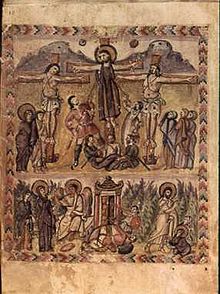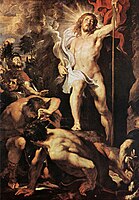Resurrection of Jesus in Christian art

The resurrection of Jesus has long been central to Christian faith and Christian art, whether as a single scene or as part of a cycle of the Life of Christ. In the teachings of the traditional Christian churches, the sacraments derive their saving power from the passion and resurrection of Christ, upon which the salvation of the world entirely depends.[1] The redemptive value of the resurrection has been expressed through Christian art, as well as being expressed in theological writings.
However, the moment of the Resurrection is not described as such in the Gospels, and for over a thousand years it was therefore not represented directly in art. Instead at first it was represented by symbolic depictions such as the
Early period

In the
An early symbol of the resurrection was the wreathed Chi Rho, whose origin traces to the victory of
The use of a wreath around the Chi Rho symbolizes the victory of the Resurrection over death, and is an early visual representations of the connection between the Crucifixion of Jesus and his triumphal resurrection, as seen in the 4th-century sarcophagus of Domitilla in Rome.[5] Here, in the wreathed Chi Rho the death and resurrection of Christ are shown as inseparable, and the Resurrection is not merely a happy ending tucked at the end of the life of Christ on earth. Given the use of similar symbols on the Roman standard, this depiction also conveyed another victory, namely that of the Christian faith: the Roman soldiers who had once arrested Jesus and marched him to Calvary now walked under the banner of a resurrected Christ.[6]
Christology and iconography

The development of iconography of the Resurrection occurred at the same time as the
The late 6th-century
Other scenes from the Gospels are the episodes.
Between the 6th and 9th centuries, the iconography of the Resurrection in the
The cosmic significance of the Resurrection in
Direct representation
From the 12th century the Resurrection itself begins to appear regularly in the West, with Christ shown emerging from what is normally shown as a Roman-style sarcophagus placed on the ground. Sometimes his torso is shown above the top edge of the sarcophagus, but more often he stands on top of it, or places one foot on the edge. The slab has always been removed (by an angel, though they are rarely shown), and may lie to one side of the scene at a diagonal angle. The
Showing Christ "hovering" above the tomb was an Italian innovation of the
Representations of the resurrection continued to evolve in the

The
Depictions of the Resurrection continued into the
Paintings with articles
- Třeboň Altarpiece, by Master of the Třeboň Altarpiece, Bohemia, c. 1380, now Prague
- Seilern Triptych, 1410–25, attr. Robert Campin, London
- The Resurrection (Piero della Francesca), 1460s, Sansepolcro
- Massa Fermana Altarpiece by Carlo Crivelli (predella scene), 1468
- Resurrection of Christ (Bellini), c. 1475, Berlin
- Resurrection of Christ (Bermejo), c. 1475, Barcelona
- Descent into Limbo (Mantegna), 1492, Bergamo
- Perugino, c. 1499, Vatican
- Resurrection of Christ (Raphael), 1499–1502, São Paulo Museum of Art
- Lamentation over the Dead Christ (Signorelli) (background), 1502, Cortona
- Florence Charterhouse, fresco by Pontormo, c. 1523-25
- Resurrection (Annibale Carracci), 1593, Louvre
- Resurrection (Rubens, Antwerp), 1611-12
- Resurrection (Rubens, Florence), c. 1616
- Resurrection (Cecco del Caravaggio), 1619, Chicago
Gallery of art
Eastern Church
-
Hosios Loukas, Greece, 11th century
-
Russian icon, 15th century
-
Yaroslavl school, 17th century
-
Five part icon, Solovetsky Monastery, 17th century
-
Modern Greek icon
Western Church
-
Ivory cover c. 400, already with sleeping soldiers; Ascension above
-
TheOttonian Bamberg Apocalypse, 11th century
-
Gothic version, from Worms Cathedral
-
Piero della Francesca, 15th century
-
Andrea Mantegna, 1457–1459
-
Raphael, Resurrection of Christ, 1499–1502
-
Lucas Cranach, 1558
-
Rubens, 1611
-
Andrea della Robbia, 16th century
-
Germain Pilon, 1572
-
Auguste Clésinger, 19th century
-
Rosary Basilica, Lourdes, 19th century, mosaic
-
James Tissot, c. 1890
-
vulning and Lamb of Godwith flag with Triumphal cross, both symbols of the Resurrection (stained glass, Ireland, 19th century)
Music
- Marc-Antoine Charpentier:
- Messe pour le samedi de Pâques, for soloists, chorus and continuo, H.8 (1690).
- Prose pour le jour de Pâques, for 3 voices and continuo, H.13 (1670)
- Chant joyeux du temps de Pâques, for soloists, chorus, 2 treble viols, and continuo, H.339 (1685).
- O filii à 3 voix pareilles, for 3 voices, 2 flutes, and continuo, H.312 (1670).
- Pour Pâques, for 2 voices, 2 flutes, and continuo, H.308 (1670).
- O filii pour les voix, violons, flûtes et orgue, for soloists, chorus, flutes, strings, and continuo, H.356 (1685 ?).
- Louis-Nicolas Clérambault: Motet pour le Saint jour de Pâques, in F major, opus 73
- André Campra: Au Christ triomphant, cantata for Easter
- Dieterich Buxtehude: Cantatas BuxWV 15 and BuxWV 62
- Carl Heinrich Graun: Easter Oratorio
- Henrich Biber: Missa Christi resurgentis C.3 (1674)
- Michael Praetorius: Easter Mass
- Johann Sebastian Bach: Christ lag in Todesbanden, BWV 4; Der Himmel lacht! Die Erde jubilieret, BWV 31; Oster-Oratorium, BWV 249.
- Georg Philipp Telemann, more than 100 cantatas for Eastertide.
- Jacques-Nicolas Lemmens: Sonata n° 2 "O Filii", Sonata n° 3 "Pascale", for organ.
- Charles Gounod: Messe solennelle de Pâques (1883).
- Nikolai Rimsky-Korsakov: La Grande Pâque russe, symphonic overture (1888).
- Sergueï Vassilievitch Rachmaninov: Suite pour deux pianos n°1 – Pâques, op. 5, n° 4 (1893).
See also
- Ascension of Jesus in Christian art
- Transfiguration of Jesus in Christian art
- Depictions of Jesus
- Last Supper in Christian art
Notes and references
- ISBN 0-8028-2417-X; p. 490
- ISBN 978-0-8010-1461-1; p. 95
- ISBN 0-8014-9306-4; pp. 5–6
- ISBN 0-415-20454-2; p. 149
- ^ "Sarcophagus of Domitilla". Archived from the original on 2010-06-24. Retrieved 2010-07-04.
- ISBN 0-7546-5011-1; p. 8
- ISBN 0-88141-149-3; p. 72
- ISBN 0-8264-1697-7; p. 114
- ISBN 0-567-08891-X; p. 72
- ^ Haney, 116
- ^ Young, 118–121
- ^ Young, 112–113
- ^ ISBN 0-567-08891-X; p. 73
- ISBN 0-88141-295-3; pp. 161–167
- ISBN 978-0-913836-99-6; p. 185
- ISBN 0-520-21932-5; p. 60
- ISBN 0-271-01670-1; p. 133
- ISBN 978-0-7546-5101-7
- ISBN 978-0-520-04081-6
- ^ Elly Cassee, Kees Berserik & Michael Hoyle, The Iconography of the Resurrection: a re-examination of the risen Christ hovering above the tomb, 1984, The Burlington Magazine, Vol. 126, No. 970 (Jan., 1984), pp. 20–24 JSTOR
- ISBN 1-110-65274-7; p. 240
- ISBN 1-4446-3978-1; pp. 355–356
- ISBN 0-8028-4676-9
- ISBN 0-313-24658-0; p. 248
- ^ Catholic Encyclopedia
Bibliography
- Haney, Kristine Edmondson, The Winchester Psalter; an iconographic study, 1986, Leicester University Press, ISBN 0-7185-1260-X.
- ISBN 978-0064300322
- Young, Brian. The Villein's Bible; Stories in Romanesque Carving, 1990, Barrie & Jenkins, ISBN 0-7126-3888-1
External links
- Age of spirituality: late antique and early Christian art, third to seventh century from The Metropolitan Museum of Art


















